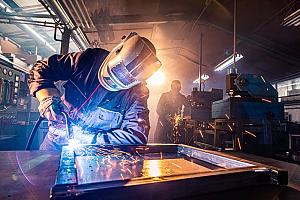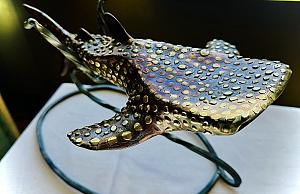Public Relations Specialist
- FMA
- The Fabricator
- FABTECH
- Canadian Metalworking
Categories
- Additive Manufacturing
- Aluminum Welding
- Arc Welding
- Assembly and Joining
- Automation and Robotics
- Bending and Forming
- Consumables
- Cutting and Weld Prep
- Electric Vehicles
- En Español
- Finishing
- Hydroforming
- Laser Cutting
- Laser Welding
- Machining
- Manufacturing Software
- Materials Handling
- Metals/Materials
- Oxyfuel Cutting
- Plasma Cutting
- Power Tools
- Punching and Other Holemaking
- Roll Forming
- Safety
- Sawing
- Shearing
- Shop Management
- Testing and Measuring
- Tube and Pipe Fabrication
- Tube and Pipe Production
- Waterjet Cutting
Industry Directory
Webcasts
Podcasts
FAB 40
Advertise
Subscribe
Account Login
Search
Pipe welding integrates machine learning to boost production
Cobot helps manufacturer increase productivity for multiple applications
- By Debra Hadden
- May 22, 2024
- Article
- Tube and Pipe Fabrication
For Joe White Tank in Fort Worth, Texas, increased demand for construction projects—and more competitive bidding for the pipe fabrication jobs within those projects—recently presented a new challenge.
The company has been in the welding industry since 1942, specializing in fabricating custom tanks, pressure vessels for industrial and ammonia refrigeration, and piping for commercial and industrial construction. It has built a reputation for quality work while consistently delivering products faster than typical market lead times.
That standard recently got put to the test, but President Jeff Yurtin and his management team aren’t people used to resting on their laurels. Rather, they’re normally on the hunt for new ways to clear the next hurdle.
The Cobot Solution
For Yurtin, the issue at hand was scaling labor for projects that can dampen productivity if they’re not managed correctly. To meet that need, he chose to invest in a Novarc Spool Welding Robot (SWR). The machine offers accurate torch control and machine learning algorithms that can detect different features of a workpiece.
The unit was designed specifically for pipes, pressure vessels, and other types of roll-welded workpieces. It features an adaptive controls system to help ensure accurate torch control, and AI/machine learning algorithms to detect weld pool features.
The SWR can integrate smoothly with the production flow and existing manufacturing processes of customers, according to Soroush Karimzadeh, Novarc’s co-founder and CEO.
“The SWR is designed with a small footprint and a very long reach, enabling it to be adopted in almost any fabrication shop, no matter the layout or various requirements,” Karimzadeh said. “It’s designed to be minimally intrusive to the production flow.”
The nature of Joe White Tank’s bread-and-butter projects can throw a kink into its work process, however. And that includes persistent labor issues.
“Piping projects can require hard starts and stops with little time to ramp your labor up and down,” Yurtin said. “Hiring and firing welders for jobs was not our idea of success. We pursued growing our business with a long-term mindset. By adding the SWR to our shop floor, we added capacity strategically and avoided many of the negative implications that come from a short-term, job-to-job labor force. And it has a small footprint; we would have had to install four manual weld cells to do the job of the SWR.”
Addressing Labor Shortages
The SWR also helps to address the nationwide shortage of skilled welders by helping less-experienced operators produce high-quality welds.

Novarc’s machine includes a user interface that has proven easy to learn for operators, regardless of experience level.
“Balancing a stable workforce with changing customer and industry demands can be difficult,” Yurtin said. “Our organization’s culture is very important to our management team. So, as we have grown our company’s market presence, we have worked to limit high employee turnover.”
The benefits of workforce continuity are legion. Not only does it give employees a greater sense of job security, but it also results in a more willing commitment to corporate goals. At a time when fabrication shops across North America are experiencing a shortage of skilled welders, “the SWR helped limit the impact of this challenge,” Yurtin said.
“We used to have a department dedicated to pipe welding, but now we have our SWR operators working with fitters, supporting them, to ramp up efficiency,” he said. “This has freed up welders to work on other projects in our backlog, shrinking our market lead time and significantly increasing our capacity. The Novarc SWR increased our capacity by 400% without reducing quality.”
The SWR accommodates users with a set of requirements for the fit-up process and provides comprehensive training for fitters.
“This is another way to ensure the integration of the SWR into our clients’ manufacturing processes is as smooth as possible,” Karimzadeh said.
With a nod to sustaining their strong corporate culture, the company’s employees are buying in, according to Yurtin.
“Anyone that’s been in the welding business for more than 10 minutes knows that the physical demands are significant,” Yurtin said. “Welders get tired.
“The ergonomics of the SWR are an immediate benefit for the welder,” he added. “They're still using their hands, but they don’t have to wear a hood, and it’s much easier with the joystick control.”
Building an Attractive Workplace
The increased productivity also created an unexpected effect on the shop floor that Yurtin recounted with a smile:
“Sometimes it’s like a game, where the welders see how much they can get through in one day, and we’re all pumped when we have a super productive day.”
With that sort of team reaction, the machine could even be seen as an aid in recruitment.
“It’s a more attractive place to work, and the younger generation of welders is really excited about automation and working with the SWR,” Yurtin said. “Even the older workers find the learning curve easy to handle.”
Often with automation comes an initial hesitancy, either about using the new technology or the need to make a change that could be perceived as high risk. Yurtin, however, chooses to focus on the ROI.
“Quick payback,” he said. “As we are able to operate four times faster, we have been able to take on more work. We would need four weld cells previously to deliver the same capacity as one SWR. And the SWR takes 25% to 30% less space. The SWR has increased our ability to accept jobs with shorter lead times, win more projects, and pursue larger bids.”
At the end of the day, safety always comes first for Karimzadeh.
“Novarc cobots are designed to follow the standard for collaborative robots and collaborative robot applications, governed by the ISO 15066 standard, so the cobot is basically equipped with force- and speed-limiting sensors to ensure that if there is a safety event, it can safely stop the work,” Karimzadeh said. “In addition, the health hazards for welders are significantly reduced, as the welding torch is moved by the cobot, and welders are not exposed to weld fumes and arc light.”
As helpful as those benefits are, the one that stands out for Yurtin is quality.
“We are mainly using the SWR to weld pipe for pressure vessels, industrial refrigeration, ammonia refrigeration—basically pipe for industrial applications,” Yurtin noted. “These need to be ASME-quality, X-ray-quality welds. And the SWR, besides being super easy to operate, has increased the quality and consistency of the welds. The SWR lays the root pass itself, and the penetration is perfect from root to cap. The SWR can handle it all. And it always passes X-ray inspection.”
Yurtin also credits the SWR for helping to position Joe White Tank as a “future-friendly” welding shop.
“We’re excited to be a showcase for innovation and believe the manufacturing industry needs to adopt new technology to be successful and meet increasing demands for productivity and competitive bidding,” he said. “Our clients are really impressed by the technology of the collaborative robot in our shop, not to mention the quality, productivity, output, and efficiency.”
Karimzadeh added, “The end users of pipe spools are pushing harder and harder regarding project delivery timelines, cost of production, and quality of welds. This is ultimately pushing the industry to automate. It’s the only way to meet the timelines, manage the cost, and maintain the quality of the work.”
For Joe White Tank, the search for new solutions to welding challenges is a constant quest for answers that improve its product, its work environment, and, ultimately, its bottom line while reflecting positively on its reputation in the industry.
About the Author
About the Publication
Related Companies
subscribe now

The Tube and Pipe Journal became the first magazine dedicated to serving the metal tube and pipe industry in 1990. Today, it remains the only North American publication devoted to this industry, and it has become the most trusted source of information for tube and pipe professionals.
start your free subscription- Stay connected from anywhere

Easily access valuable industry resources now with full access to the digital edition of The Fabricator.

Easily access valuable industry resources now with full access to the digital edition of The Welder.

Easily access valuable industry resources now with full access to the digital edition of The Tube and Pipe Journal.
- Podcasting
- Podcast:
- The Fabricator Podcast
- Published:
- 06/11/2024
- Running Time:
- 61:23
Jeff Cupples, the president of Jackson, Tenn.-based Cupples J&J Company, discusses his experience with laser cutting machines and...
- Industry Events
Golf 4 Manufacturing
- June 3 - August 18, 2024
- Waukegan,
Advanced Laser Application Workshop
- June 25 - 27, 2024
- Novi, MI
Precision Press Brake Certificate Course
- July 31 - August 1, 2024
- Elgin,
Laser Welding Certificate Course
- August 6 - 8, 2024
- Farmington Hills, IL
The Fabricator's Technology Summit
- August 20 - 21, 2024
- Eglin, IL
































